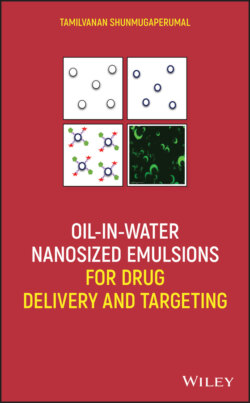Читать книгу Oil-in-Water Nanosized Emulsions for Drug Delivery and Targeting - Tamilvanan Shunmugaperumal - Страница 21
1.1.2.3. Classification of Oil‐in‐Water Nanosized Emulsions
ОглавлениеPurely based on the emulsifier combinations used to stabilize the dispersed oil droplets of the emulsions, the o/w nanosized emulsions can be classified into three types (Fig. 1.2). First type includes emulsions prepared using the emulsifiers that are having the capacity to assemble at the o/w interface and able to produce a minus (negative) charge in the vicinity of dispersed oil droplets of the emulsions. The emulsions thus formed are termed as anionic or negatively‐charged emulsions. The emulsions made with the inclusion of emulsifiers that are assembled at the o/w interface and competent to confer a plus (positive) charge in the vicinity of dispersed oil droplets of the emulsions are called as cationic or positively‐charged emulsions. The literature suggests that neither triglycerides nor phospholipidic emulsifier's components of the conventional or anionic emulsions are able to significantly sustain the incorporated lipophilic API release in simulated or real physiological environments under sink conditions. Therefore, in an attempt to prolong and/or optimize the API release, cationic lipid or polysaccharide emulsifiers are added to the emulsions to elicit mucoadhesion with anionic ocular tissues by an electrostatic adhesion. Indeed, cationic emulsions prepared on the basis of stearylamine, oleylamine and chitosan can serve this purpose. It was initially believed and now has become clearer from many reports in the literature that an occurrence of electrostatic attraction between the cationic emulsified droplets and anionic cellular moieties of the ocular and topical skin surface tissues enhance the bioavailability of emulsions containing lipophilic APIs (Lallemand et al. 2003; Piemi et al. 1999; Tamilvanan et al. 2002; Vandamme 2002). There is another type of emulsions that are neutral in terms of the charge on the dispersed droplets. These are instead stabilized through steric effects exerted by the emulsifier molecule present in the emulsion formulation.
Figure 1.2. Classification of oil‐in‐water (o/w) nanosized emulsions based on emulsifier molecules.
According to Capek (2004), the stability of the electrostatically‐ and sterically‐stabilized o/w nanosized emulsions can be controlled by the charge of the electrical double layer and the thickness of the droplet surface layer formed by non‐ionic emulsifier, respectively. In spite of the similarities between electrostatically‐ and sterically‐stabilized emulsions, there are large differences in the partitioning of molecules of ionic and non‐ionic emulsifiers between the oil and water phases and the thickness of the interfacial layers at the droplet surface (Capek 2004). The thin interfacial layer (the electrical double layer) at the surface of electrostatically stabilized droplets does not create any steric barrier for mass transfer. This may not necessarily be true for the thick interfacial layer formed by a non‐ionic emulsifier. The sterically‐stabilized oil droplets, however, can favor the transfer of materials within the intermediate agglomerates. Hence, the stability of electrosterically‐stabilized emulsion (δk) is controlled by the ratio of the thickness of the non‐ionic emulsifier adsorption layer (δ) to the thickness of the electrical double layer (k−1) around the oil droplets (Capek 2004).
(1.5)
